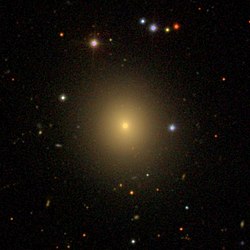
NGC 5929 is a Seyfert galaxy in the constellation Boötes. The pair of galaxies, NGC 5929 and NGC 5930, are interacting.
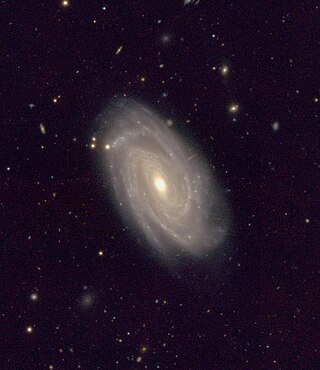
NGC 10 is a spiral galaxy located in the southern constellation of Sculptor. It was discovered by John Herschel on 25 September 1834. The galaxy is located at a distance of 346 Mly from the Sun. Its morphological classification in the De Vaucouleurs system is SAB(rs)bc, where the 'SAB' denotes a weak-barred spiral, '(rs)' indicates a slight ring-like structure, and 'bc' means the spiral arms are moderately to loosely wound. Paturel et al. (2003) assigned this galaxy a classification of SBbc, indicating a barred spiral galaxy.
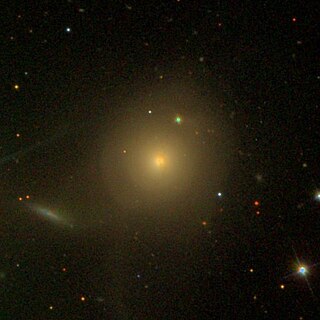
NGC 467 is an unbarred lenticular galaxy in the constellation Pisces. It was discovered on 8 October 1785 by William Herschel.

NGC 6384 is an intermediate barred spiral galaxy located about 77 million light-years away in the northern part of the constellation Ophiuchus. It has a morphological classification of SAB(r)bc, indicating that it is a weakly barred galaxy (SAB) with an inner ring structure (r) orbiting the bar, and moderate to loosely wound spiral arms (bc). The galaxy is inclined by an angle of 47° to the line of sight, along a position angle of 40°. The estimated mass of the stars in this galaxy is 105 billion times the mass of the Sun.
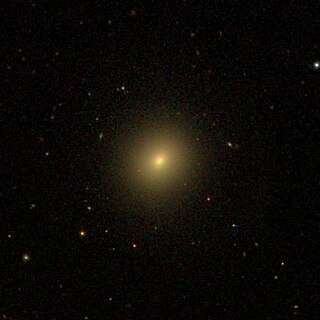
NGC 113 is an unbarred lenticular galaxy located in the constellation Cetus. It was discovered by German astronomer, Ernst Wilhelm Leberecht Tempel, on August 27, 1876.

NGC 4293 is a lenticular galaxy in the northern constellation of Coma Berenices. It was discovered by English astronomer William Herschel on March 14, 1784, who described it as "large, extended, resolvable, 6 or 7′ long". This galaxy is positioned to the north-northwest of the star 11 Comae Berenices and is a member of the Virgo Cluster of galaxies. It is assumed to lie at the same distance as the Virgo Cluster itself: around 54 million light years away. The galaxy spans an apparent area of 5.3 × 3.1 arc minutes.
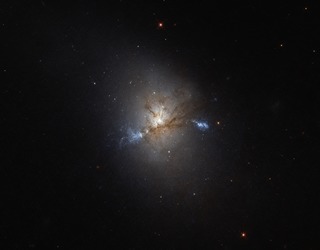
NGC 1222 is an early-type lenticular galaxy located in the constellation of Eridanus. The galaxy was discovered on 5 December 1883 by the French astronomer Édouard Stephan. John Louis Emil Dreyer, the compiler of the New General Catalogue, described it as a "pretty faint, small, round nebula" and noted the presence of a "very faint star" superposed on the galaxy.

NGC 741, also known as PGC 7252, is a formerly active radio galaxy in the constellation of Pisces. Located 74.13 Mpc away, NGC 741 is part of a group of galaxies including NGC 742 and PGC 7250. NGC 741 and NGC 742 recently collided, although the disruption was minor. Radio filaments have been found connecting NGC 741 to NGC 742, and due to the bent structure of the radio filaments, NGC 741 is estimated to be moving at 1400 km/s with respect to its local group, suggesting that ram-pressure stripping was created as a product of the former merger.

NGC 880 is a spiral galaxy located in the constellation Cetus about 590 million light-years from the Milky Way. It was discovered by the American astronomer Francis Leavenworth in 1886.

NGC 850 is a lenticular galaxy in the constellation Cetus. It is estimated to be 300 million light-years from the Milky Way and has a diameter of approximately 130,000 ly.

NGC 860 is an elliptical galaxy located in the constellation Triangulum. It is about 410 million light-years from the Milky Way. It was discovered by the French astronomer Édouard Stephan in 1871.

NGC 910 is an elliptical galaxy in the constellation of Andromeda. NGC 910 was discovered on October 17, 1786 by the German-British astronomer William Herschel. It is the brightest galaxy in the cluster Abell 347.

NGC 906 is a barred spiral galaxy in the constellation Andromeda in the northern sky. It is estimated to be 215 million light years from the Milky Way and has a diameter of approximately 110,000 ly. NGC 906 was discovered on October 30, 1878 by astronomer Édouard Stephan.

NGC 812 is a spiral galaxy located in the Andromeda constellation, an estimated 175 million light-years from the Milky Way. NGC 812 was discovered on December 11, 1876 by astronomer Édouard Stephan.
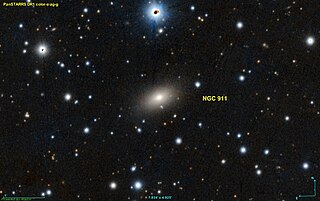
NGC 911 is an elliptical galaxy located in the constellation Andromeda about 258 million light years from the Milky Way. It was discovered by French astronomer Édouard Stephan in 1878. It is a member of the galaxy cluster Abell 347.
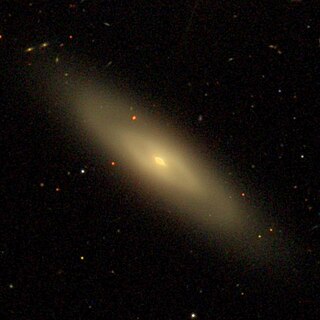
NGC 3301, also known as NGC 3760, is a lenticular galaxy in the constellation Leo. Its apparent magnitude in the V-band is 11.1. It was first observed on March 12, 1784, by the astronomer William Herschel. It is a member of the Leo II Groups, a series of galaxies and galaxy clusters strung out from the right edge of the Virgo Supercluster.

NGC 861 is a spiral galaxy in the constellation Triangulum. It is estimated to be 360 million light-years from the Milky Way and has a diameter of approximately 165,000 light-years. The object was discovered on September 18, 1865 by Heinrich d'Arrest.
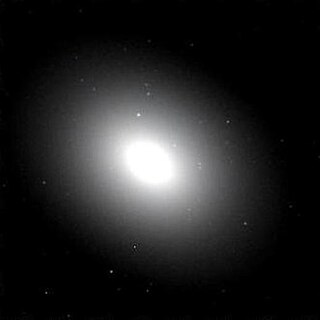
NGC 4365 is an elliptical galaxy located in the constellation Virgo. It was discovered by William Herschel on April 13, 1784.

NGC 3619 is an unbarred lenticular galaxy located in the constellation Ursa Major. It was discovered by the astronomer William Herschel on March 18, 1790.

NGC 677 is an elliptical galaxy located in the constellation Aries. It was discovered on September 25, 1886, by the astronomer Lewis A. Swift. It is located about 200 million light-years from Earth at the center of a rich galaxy cluster. It has a LINER nucleus.
